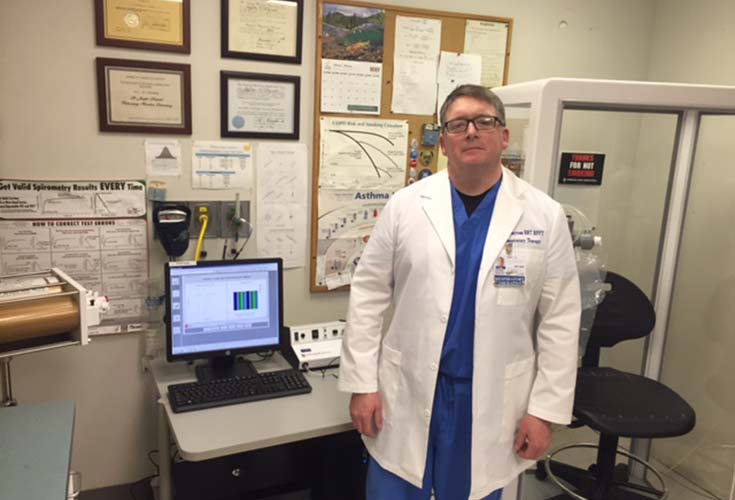 AARC member Jeffrey Haynes shares why he loves his chosen specialty of pulmonary diagnostics.
AARC member Jeffrey Haynes shares why he loves his chosen specialty of pulmonary diagnostics.
By Jeffrey M. Haynes, RRT, RPFT, FAARC
My path to a career in respiratory care began in a 10th-grade biology class. We were instructed to write a report about one of the organ systems of the body and I was randomly assigned the respiratory system. I was given a pair of piglet lungs in a jar to take home, which I kept on my desk while I read about the respiratory system and wrote my report. From that point on I’ve been fascinated by respiratory physiology.
I had planned to explore a career as a paramedic and took a class called “health occupations.” I spent time at the local hospital to learn about possible career paths in health care and that’s when I learned about respiratory therapy. I had never heard of a “respiratory therapist” before, but instantly knew that I wanted to be one.
Drawn To PFTs
I enjoyed learning how to function as a respiratory therapist in college, but my favorite topic was always the physiology. My love of respiratory physiology drew me like a magnet into the pulmonary function lab. Being able to quantify pulmonary physiology statistically and graphically quickly became a passion.
I found teaching patients how to perform the tests correctly in order to capture their true function both challenging and rewarding. I realized early on that there was an infinite volume of information to learn and that I would need to commit to career-long learning to be a good technologist.
I have been performing PFTs for 28 years now and when patients ask me, “how long did you have to train to do this job?” I reply, “28 years, and if you ask me next year I’ll say 29 years.” The journey of learning about pulmonary physiology is like a great novel that never ends. I love it.
Attaining the RPFT
Attaining the NBRC RPFT credential was an important moment in my career. Top clinicians in the field like Gregg Ruppel and Jack Wanger had their RPFT credential, so I felt it was important to distinguish myself as not just another RT who also does PFTs.
Several co-workers who heard that I was planning to take the RPFT exam voiced skepticism about the prospects of passing the test on my first attempt. “That’s the hardest NBRC test to pass,” they said, and “Most people fail that test.”
Their comments were actually quite helpful because I became even more driven to pass the exam. I learned a lot studying for the exam and gained an appreciation for being knowledgeable about tests and procedures that were not performed in my laboratory.
Commitment To Quality
Today I oversee the same small lab that I starting in so many years ago. I’m very proud of our commitment to quality assurance and the addition of new testing protocols like exercise laryngoscopy.
I have found that conducting research in diagnostics is more feasible than in critical care, especially if you practice in a non-academic center like mine. I am still involved in critical care and believe that my assessments and decision-making in the ICU are better because of what I have learned about pulmonary physiology in the PFT lab.
Great Satisfaction in Pulmonary Diagnostics
Some may view pulmonary function testing as a boring job because you do the same tests over and over again. However, a patient’s diagnosis, need for medication, or suitability for potentially life-saving surgery can hinge on the PFT results a technologist submits for interpretation. You can enjoy great satisfaction in knowing that you’ve prepared yourself and your lab to serve your patients well by consistently reporting accurate, high-quality data.
Jeffrey Haynes is clinical coordinator, respiratory therapy and PFT laboratory, at St. Joseph Hospital in Nashua, NH. He also serves as a member of the NBRC Pulmonary Function Examination Committee.





